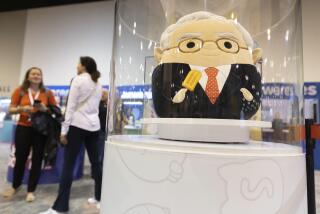Build-A-Bear Is Standing Out in Market
- Share via
Thirty years ago, the toy industry was basically a collection of dolls, plush bears, building sets, Slinkys and electric trains.
Today -- with the state of play radically transformed by ultra-violent video games, high-tech interactive toys that remember your name, and Beyonce and Lindsay Lohan fashion dolls -- nothing seems the same.
But one thing hasn’t changed. Don’t bet against the bear.
Here’s proof: The stock of Build-A-Bear Workshop Inc., described as “a beary special place,” has increased 85% since it went public last fall by offering a novel concept to a stagnant industry.
“We don’t think of ourselves as a toy company,” said Maxine Clark, founder and chief executive of St. Louis-based Build-A-Bear. “We sell an experience.”
The consumer’s experience -- creating a soft toy and customizing it -- involves selecting an animal skin, stuffing and stitching, and choosing outfits with accessories such as shoes, glasses and cellphones.
Clark’s company went public in October. The first store opened in 1997, and Build-A-Bear now has 170 locations in Canada and the U.S. and stores in Britain, Australia, Japan, Denmark and South Korea.
In California, there are 13 Build-A-Bear stores, including at Downtown Disney in Anaheim, the Glendale Galleria and Fashion Island in Newport Beach.
Although the shares have jumped, not everyone is convinced.
In the 30 days ended Feb. 15, 2.3 million shares, or 31%, of Build-A-Bear’s publicly traded stock was sold short, double the amount in December. Rising short positions can be a negative sign for a company, as it shows that a growing number of investors are betting against it.
The company reported net income of $20 million, or $1.07 a share, for 2004, up from restated 2003 earnings of $7.6 million, or 43 cents. Revenue increased 41% to $301.7 million.
In addition to traditional stores, Build-A-Bear has a mobile store in an 18-wheeler that is driven around the country to public gatherings such as state fairs and sporting events.
The workshop is not for bears only. Customers also can build rabbits, frogs and Elmo, the “Sesame Street” character.
Even so, Clark’s ambitions remain relatively modest.
“Our long-term plan is to have 350 stores in the U.S. and Canada and 350 additional stores internationally,” Clark said. “For most retail chains that’s a drop in the bucket. I don’t think that’s saturation.”
“It’s amazing they [Build-A-Bear] haven’t experienced more successful competition because, on the surface, it looks like a very simple concept,” said Sean McGowan, an analyst with Harris Nesbitt. “There are people doing similar things but they seem to have found the right formula: service, a great product, and really emphasizing the experience.”
The U.S. toy industry has been in a rut. In 2004, sales fell 3% after years of weakness. What’s more, kids are bypassing traditional toys for electronics, clothing and video games.
“Build-A-Bear is a new type of toy store where there’s interactivity. Kids love differentiation. They like to have something that’s their own,” said Jim Silver, publisher of toy industry trade magazines.
Build-A-Bear’s shares rose $1.04 to $31.90 on Tuesday on the New York Stock Exchange.
More to Read
Inside the business of entertainment
The Wide Shot brings you news, analysis and insights on everything from streaming wars to production — and what it all means for the future.
You may occasionally receive promotional content from the Los Angeles Times.










